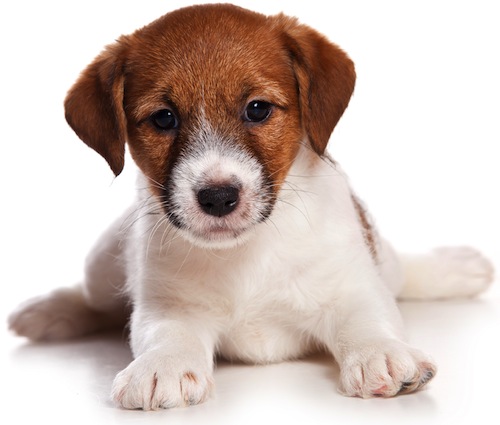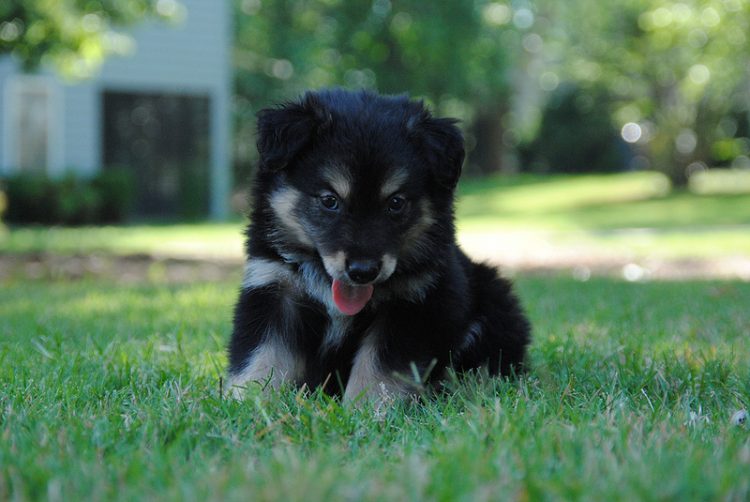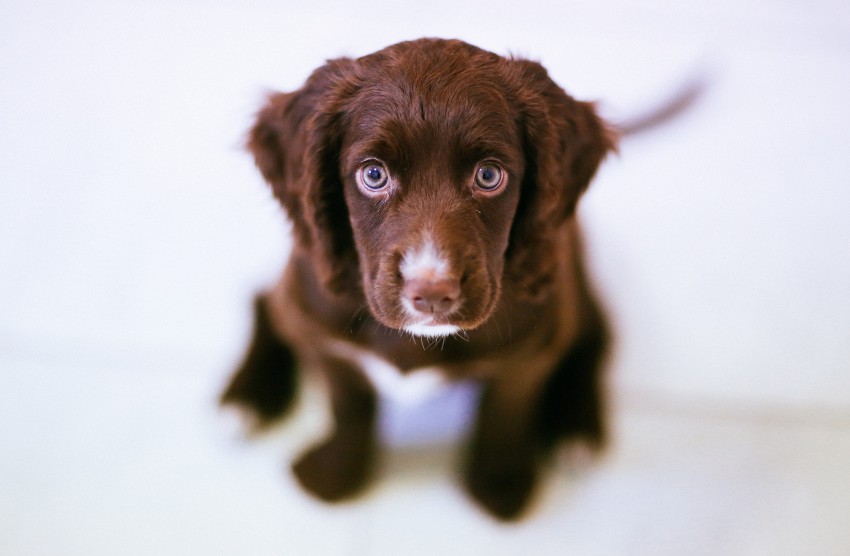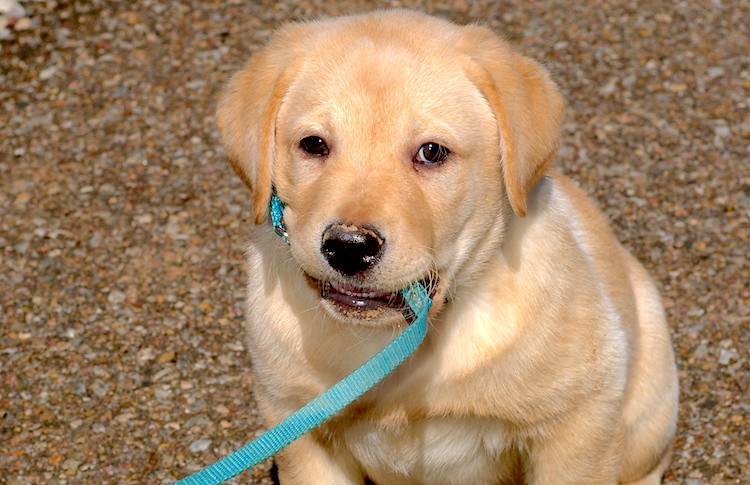This comprehensive guide on how to potty train a puppy was written by a team including Melissa Smith, a professional pet sitter, and former shelter worker Allison Gray. Petful editor-in-chief Kristine Lacoste and writers C.D. Watson and Roseann Lahey also contributed. Originally published in 2009, this article has been regularly reviewed and was last updated on May 10, 2024.

If you have a new puppy, it’s surely an exciting time. But you may be dreading house-training the puppy.
Don’t lose heart — although properly learning how to potty train a puppy takes time, it may not drag on as long as you’d think.
Read on to discover the best methods for how to potty train a puppy the right way in a short amount of time.
How to Potty Train a Puppy
The first key to effectively potty training a puppy is to observe your pet’s behavior.
Your puppy may need to go potty 8–10 times a day and usually needs to go shortly after waking, eating, drinking, or playing.
Learn to understand your dog’s body language when they have to go:
- When you notice the puppy whimpering, whining circling, and sniffing, it’s time.
- Take them to the potty area immediately.
If the potty area is outside, your puppy will eventually go to the door as an indication.
If you are using papers or pee pads, place them in the same designated area and train to that spot.
Use a keyword: As your dog is peeing or pooping say, “Go pee pee,” or “Go potty.” They will begin to understand the correlation of the word.
Above all, be consistent with your house-training regimen.

Should You Crate Train Your Puppy?
As long as it’s the right size — and you keep it clean and comfortable — a crate is an excellent way to help in how to potty train a puppy in a short period of time.
Certified master dog trainer Lori Verni explains:1
“Most dogs will instinctively keep their confinement area clean…. Let’s say you’re going out for 2 hours. If your dog is in an area where he doesn’t want to eliminate, he will ‘hold it in’ until you get home.”
The 3 benefits of consistent crate training, according to Verni:
- “There are no ‘gifts’ on your rug when you return.”
- “As soon as you return home, you will walk your dog and have the opportunity to praise him for going in the right place (outside).”
- “Your dog is building up muscle control so he can eventually last for the needed periods of time (e.g., a reasonable work day or overnight).”
A young puppy should never be given free rein of the house.
House-training requires confinement of some sort, for your puppy’s protection and yours.
The natural instinct of a puppy to seek safety and comfort from the den-like enclosure of a crate makes it a perfect house-training tool. Dogs typically will not soil their sleep area.
Crates also protect your belongings from sharp dog teeth and protect your pet from electric cords, plants, stairs, and areas that require supervision.
But if you want this to work, you’ve got to know how to properly crate train your puppy.
Follow these guidelines for crate training:
- Never use the crate as a punishment. Your pet will come to fear it and refuse to enter it.
- Puppies younger than 6 months shouldn’t stay in a crate for more than 3–4 hours at a time. They can’t hold it for that long. The same goes for adult dogs who are being house-trained. Physically they can hold it, but they don’t know they’re supposed to do this.
- Crate your dog only until you can trust them not to destroy the house. After that, the crate should be a place they go to voluntarily.
- If your puppy continually soils the crate, discontinue using it for house-training.
Always take your puppy to the designated potty area as soon as you take them out of the crate or area of confinement. Reward them as soon as they relieve themselves. Take a look at our recommended puppy crate.
Use a Designated Bathroom Area
Using a designated spot outdoors is another way of consistently achieving success in how to potty train a puppy.
- Choose a spot that is easy to access all year long. “Remember, if you don’t want to wade through waist-high snow (or leaves, sticks, or whatever), neither will your dog,” says Verni.
- Then, start bringing your puppy to that same spot frequently.
- When your puppy goes potty there, praise them effusively and reward them.
- They will quickly learn that when they potty in this one special area, they will get rewarded handsomely.
“The area will quickly become a ‘trigger,’” says Verni. “Every time you bring your dog to that spot, he will go if he has to.”
“In fact, most dogs will at least squeeze out a few drops simply because of the subconscious need associated with that area, combined with the desire to receive your praise.”
How to Get Your Dog to Ask to Go Outside
We all wish our dogs could just talk. It would make life so much easier for us, right?
Fortunately, there are lots of ways to train your dog to communicate what they need. Here are just 3 examples of how to teach your dog to tell you that they need to go out.
1. Follow a Routine
Being on a schedule is key.
If you leash Charlie at 9 o’clock every evening for a loop around the block, he’s going to begin expecting that quick walk.
And because dogs are creatures of habit, when you forget to take them outside, they’re going to remind you.
With that in mind, choose your dog’s bathroom breaks at convenient times. Select a time when you’re usually home and free. As you continue that routine, your dog will grow accustomed to it.
2. Use a Bell
Dogs are clever. They’re eager to learn and can be trained to perform simple tasks, such as ringing a bell.
As it turns out, a bell-ringing dog can be very useful if you don’t want to clean up accidents every time your pup needs to go outside.
Keep in mind that the bells should be:
- Loud: You want to hear when your dog rings the bells, even if you’re in another room.
- Accessible: Your dog should be able to reach the bells easily. Keep the bells low and visible.
- Durable: If your dog is excited about getting outside, they may paw enthusiastically at the bell, and you don’t want the bell to break. Make sure the bell can withstand a little rough handling.
Having the bells and actually teaching your dog to use them are not the same. Your dog isn’t going to know to paw at the bells every time they go out. You have to show them that a ringing bell means outside time.
Doing that may be as simple as ringing the bell yourself each and every time you take your dog outside. Try not to forget to ring the bell and, eventually, your pup will begin associating the bell ringing with getting a bathroom break. Here’s our recommended Pet Training Bells
3. Bring the Leash
If your puppy likes bringing you toys, newspapers, and shoes (even when you didn’t actually ask for them), your pet could be the perfect candidate for learning how to fetch their leash every time they need to go outside.
Was YOUR Pet Food Recalled?
Check Now: Blue Buffalo • Science Diet • Purina • Wellness • 4health • Canine Carry Outs • Friskies • Taste of the Wild • See 200+ more brands…

Try the following steps to teach your dog to bring you the leash to go outside:
- Keep the leash near the door and somewhere accessible for the dog. When you take your dog out, first give them the leash to hold in their mouth.
- After they get the hang of that, give them the leash and walk away a couple of feet to encourage them to bring it to you.
- When they let you have the leash, make sure you praise them and take them right out.
- Work with them until they start collecting the leash alone and, without your guidance, they’ll start bringing it every time they need to go out.
This sort of training takes time and patience. Be consistent in your methods, and eventually you’ll have a dog who’s happy to tell you when it’s time for a walk. Check out our recommended dog leash.

Initial Steps for House-Training Success
Reward, Don’t Punish
Animal experts agree that rewards are the most successful training reinforcement. Never punish your puppy for accidents.
Let’s recap what to do:
- As soon as your dog successfully goes potty in the designated training spot, praise them and offer a treat.
- And if your dog does make a mistake, don’t scold or reprimand. Just clean up and start back with the training.
Punishments, either by scolding or physical corrections, create distrust from your dog. You may end up with a dog who is fearful and anxious. Puppies who are scared may even submissively urinate or urinate out of fear, which results in exactly what you are trying to avoid: urine on your floors.
Just keep in mind that if your dog soils in the wrong place, they don’t understand the mistake. Correcting them after the fact, even seconds later, won’t work.
Do the following if your dog makes a mistake in the house:
- Clean the floor thoroughly with an enzymatic solution.
- Do not use ammonia — dogs instinctively return to areas marked with the scent of their waste, and they may confuse the smell of ammonia with that of urine.
Be Consistent When House-Training a Puppy
Consistency is key to house-training a puppy quickly.
Monitor how often your puppy needs to go potty and try to get them outdoors before any accidents happen. If you do this consistently, your puppy should quickly catch on.
Pet expert Shirley Kalstone confirms the importance of consistency in her book How to Housebreak Your Dog in 7 Days:4
“When a healthy dog cannot be [trained] within a week, give or take a few days, it’s probably due to the owner’s procrastination or inconsistency.”
People who are not consistent will find that their puppy takes longer to train because the dog is not getting the same message every time they go potty.
Plan to have someone home with your puppy at all times, and be ready to get up in the middle of the night.
Clean Up Accidents Quickly and Thoroughly
This is a big one that often goes ignored.
Dogs have a super-keen sense of smell. When they smell urine in a particular place — say, on your carpet — they will immediately go to that spot and cover it up with fresh pee. You can avoid this with thorough cleaning.
Urine accidents that happen on hard surfaces, such as ceramic tile, concrete floors, or linoleum, are easy to handle:
- Absorb the urine with plenty of paper towels.
- Mix up a bucket of bleach and hot water.
- Scrub the soiled area with the mixture to eliminate any residual odor the puppy may pick up.
The better you are at cleaning these dirtied areas, the less likely your dog is to have additional accidents.
In the video below, from Vet Med Corner, Doctor M gives an overview of some puppy house-training methods:
Practice, and Patience, Make Perfect When Learning How to Potty Train a Puppy
House-training a puppy takes compassion, consistency, and patience.
It is your responsibility to help your puppy understand where and when to potty.
Let’s try to simplify this. Regardless of the method, house-training a puppy employs 2 general guidelines:
- Prevent indoor accidents by confinement, observation, and close supervision.
- Take your puppy outside on a regular schedule and reward them for eliminating in the designated area.
Remember, a puppy less than 12 weeks old will not have developed bladder or bowel control. A dog may not be fully house-trained until 8–12 months old.
What to Do If Your Puppy Pees Inside
If Your Puppy Starts to Go in the House
Puppies are babies, and they will forget training if they are involved in a more interesting activity.
Sometimes the urgency hits, and they will just start to pee before they give a signal.
As soon as you see your puppy begin to urinate or defecate in the wrong place:
- Scoop them up and get them to the right potty place.
- Then, once at this correct spot, encourage them to continue elimination with your special command and then praise the puppy.

Why Rubbing a Dog’s Nose in Pee Does Not Work
The thought of someone rubbing a dog’s nose in pee makes the hair on the back of our neck stand up. We can’t understand why someone would think this is an acceptable way to house-train a puppy.
It is definitely not acceptable and it does not help in answering the question, How to potty train a puppy. According to American Humane, you should “never rub a dog’s nose in urine or feces, or punish a dog for an ‘accident.’ This will teach your dog to fear you, and he may hide when he has to ‘go.’”2
“It’s way too late” when there is already pee on the floor,” agrees professional dog trainer Lisa Patrona.3
She says it “really constitutes abuse, since there is no way for your dog to understand why you’re acting the way you are toward him, much less what on earth you’re so upset about.”
Troubleshooting Potty Training Issues
How to Stop a Puppy from Peeing in the Crate
Make sure the crate is the right size, provide regular potty breaks, and remove the water bowl an hour before bedtime.
Reinforce positive behavior with rewards and make the crate a comfortable, anxiety-free space with toys and treats.
If problems persist, consider using a puppy playpen or consult a vet to rule out medical issues.
Magic Formula on How to Potty Train a Puppy?
Unfortunately, there are no magic formulas for house-training a puppy successfully.
It requires you to invest the time and the effort. The payoff, though? A happy, trusting relationship with your new pet.
If you find you need additional help, professional guidance is available. Contact a certified professional dog trainer, a certified applied animal behaviorist, or a board-certified veterinarian behaviorist.

Litter Box Training a Dog
We hear litter box and instantly think of cats — but what about dogs? Can dogs be trained to use a litter box?
The surprising answer is yes.
It’s not for everyone, but some people have asked us about it. This section of the article will cover litter box training for a dog.
Dog Litter Box Training: An Overview
Unlike cats, dogs normally need to go outside to relieve themselves.
But this may not always be feasible if you live in a tall building, work long hours, or can’t make it to the door in time.
Litter boxes provide an additional place for your dog to go when needed. This isn’t considered a replacement for going outside completely, but an inside aid to limit the need to go outside as often.
Litter box training a dog is easier for younger or smaller dogs, but it’s also possible with older and larger dogs.
In the video below, a dog breeder talks about dog litter boxes. Watch this, and then we’ll tell you what you’ll need to get started:
Essential Supplies for Litter Box Training a Dog
First, you will need a litter box, obviously:
- Depending on the size of your dog, a regular litter box will do as long as it is a few inches deep. There should be enough room for your dog to walk around and choose a spot.
- For male dogs who lift their leg to pee, some people have used a covered litter box with the top and opening cut out. This way the back and sides will (with any luck) catch any urine that misses the box while still keeping an open feel.
- Larger dogs will need larger boxes, and some people have used large travel crates and cut out the top and front for this purpose.
If you start with a puppy, expect to replace the box size as the puppy grows. Check out our recommended litter box for dogs.
Filler is important, too:
- Don’t use regular cat litter in your dog’s litter box. Some cat litter can cause health problems in dogs who eat poop.
- If your dog is already used to pee pads or newspaper, start moving these into and around the litter box. The scent and material should let your dog know that this is an acceptable place to go.
- Use the same filler. Don’t change litter types once your dog is used to it. This can cause confusion or accidents.
Fencing-in the area or making a barrier offers some privacy and keeps the contents contained. You can use plastic lattice sheets or gates near openings. This is optional, but it will help keep the area clean.
Steps to Effective Litter Box Training
If going indoors or on newspaper is new for your dog, you will need to train the dog to become familiar with the area.
You can also soak some newspaper in their urine or bring some feces from outside and place it in the box to show them that this is acceptable.
If your dog signals for you to let them out, try leading them to the box area to familiarize them with the process. If your dog does use the area, offer lots of praise.
Accidents can happen, so have cleaner on hand and show the dog the litter box area. There can be several reasons for the accident, such as not making it to the box in time or missing the box while going. A firm “No!” and placing the dog in the box will help reinforce the proper area for peeing. If the dog goes after being placed in this area, offer praise.
Once the dog gets used to the newspaper or if using pads, you can slowly start incorporating the dog litter with the existing items:
- Each week, start using less newspaper and more litter until all that is left is litter.
- Use reinforcement with words such as “Go potty,” and praise your pet every time they use the litter box.
After Litter Box Training the Dog, Can I Quit Letting the Dog Out?
Don’t have unrealistic expectations.
Litter box training a dog is great as a backup so your pet doesn’t have to hold it forever — but you should still set aside time to go outside for potty and play.
This method can be great for small dogs with small bladders or older dogs who may need to go more frequently.
Suggested Puppy Potty Training Essentials
Petful is reader-supported. As an affiliate of platforms like Amazon, we may earn a commission when you buy through links on this page at no extra cost to you. Our recommendations are unbiased and chosen with your best interest in mind.
Frequently Asked Questions (FAQ)
What is the fastest way to potty train a puppy?
Consistency is crucial—establish a regular feeding schedule, use a crate for house training, take your puppy to the same spot outside frequently, and reward with praise and treats immediately after they go.
At what age should a puppy be fully potty trained?
Most puppies are fully potty trained by 6 months, though some may take up to a year with consistent training.
How to potty train a dog in 3 days?
Use a crate for confinement, take your dog outside frequently (every 1-2 hours and after meals), and consistently reward with praise and treats immediately after they go.
Can an 8-week-old puppy be potty trained?
Yes, you can start potty training an 8-week-old puppy, but expect gradual progress with consistent effort.
References
- Verni, Lori, certified master dog trainer. Everything You Need to Know About House Training Puppies & Adult Dogs. Best Paw Forward Dog Education Inc., 2005. 6.
- “Housetraining Puppies & Dogs.” American Humane. Aug. 25, 2016. http://www.americanhumane.org/fact-sheet/housetraining-puppies-dogs/.
- Patrona, Lisa, DipCBST, CPDT-KA, ACDBC. “Common Myths (And Mistakes) Associated With the House Training Process.” https://www.woofology.com/housetrainingmythsmistakes.
- Kalstone, Shirlee. How to Housebreak Your Dog in 7 Days. Random House Publishing Group. 2009.




